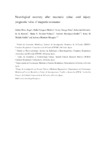Mostrar o rexistro simple do ítem
Neurological recovery after traumatic spinal cord injury: prognostic value of magnetic resonance
| dc.contributor.author | Mora-Boga, Rubén | |
| dc.contributor.author | Vázquez-Muíños, Olalla | |
| dc.contributor.author | Pértega-Díaz, Sonia | |
| dc.contributor.author | Salvador-De la Barrera, Sebastian | |
| dc.contributor.author | Ferreiro-Velasco, María Elena | |
| dc.contributor.author | Rodríguez-Sotillo, Antonio | |
| dc.contributor.author | Meijide-Faílde, Rosa | |
| dc.contributor.author | Montoto Marqués, Antonio | |
| dc.date.accessioned | 2022-02-25T12:46:14Z | |
| dc.date.issued | 2022-02-01 | |
| dc.identifier.citation | Mora-Boga R, Vázquez-Muíños O, Pértega-Díaz S, Salvador-de la Barrera S, Ferreiro-Velasco ME, Rodríguez-Sotillo A, Meijide-Failde RM, Montoto-Marqués A. Neurological recovery after traumatic spinal cord injury: prognostic value of magnetic resonance. Spinal Cord. 2022 Jun;60(6):533-539. | es_ES |
| dc.identifier.issn | 1362-4393 | |
| dc.identifier.uri | http://hdl.handle.net/2183/29847 | |
| dc.description.abstract | [Abstract] Study design: Retrospective observational study. Objectives: Assess the relationship between Magnetic Resonance (MR) image patterns and neurological recovery in patients with Traumatic Spinal Cord Injury (TSCI). Setting: Spinal cord injury unit in Spain. Methods: Patients admitted for acute TSCI between January 2010 and December 2018 with a MR exam performed in the acute phase were selected. Five patterns were established: normal, single-level edema, multilevel edema, hemorrhage, and spinal cord transection. Comparisons between the ASIA Injury Severity (AIS) score and Motor Index (MI) at admission and at discharge were made. Results: Collected 296 patients. Normal and cord transection patterns were excluded due to the low number of cases. Single-level edema pattern was primarily observed in cases with incomplete injuries, hemorrhage pattern in complete injuries, and multilevel edema pattern at similar percentages in complete and incomplete lesions. Improvement of the AIS score was found in 40.9% of single-level edema, 20.2% of multilevel edema, and 19.0% of hemorrhage (p = 0.042) patterns. By excluding the AIS grade D from the analyses, the figures increased to 70.3%, 52.2%, and 19.4% respectively (p < 0.001). This significant relationship was confirmed by multivariate analysis, although it was not as relevant as the examination according to ASIA-ISCoS performed at admission (p = 0.005 vs p < 0.001). Mean variation of the MI was also significantly different (p < 0.001) between the three groups: 22.6 ± 21.4 for single-level edema, 16.9 ± 21.1 for multilevel edema, and 4.5 ± 8.4 for hemorrhage. Conclusion: MR injury patterns observed at the acute phase are associated with the possibility of improvement of the AIS score and MI. | es_ES |
| dc.language.iso | eng | es_ES |
| dc.publisher | Nature | es_ES |
| dc.relation.uri | https://doi.org/10.1038/s41393-022-00759-0 | es_ES |
| dc.title | Neurological recovery after traumatic spinal cord injury: prognostic value of magnetic resonance | es_ES |
| dc.type | journal article | es_ES |
| dc.rights.accessRights | embargoed access | es_ES |
| dc.date.embargoEndDate | 2022-07-01 | es_ES |
| dc.date.embargoLift | 2022-07-01 | |
| UDC.journalTitle | Spinal Cord | es_ES |
| UDC.coleccion | Investigación | es_ES |
| UDC.departamento | Fisioterapia, Medicina e Ciencias Biomédicas | es_ES |
| UDC.grupoInv | Grupo de Investigación en Terapia Celular e Medicina Rexenerativa (TCMR) | es_ES |
Ficheiros no ítem
Este ítem aparece na(s) seguinte(s) colección(s)
-
Investigación (FCS) [1293]






